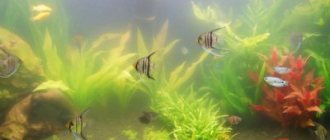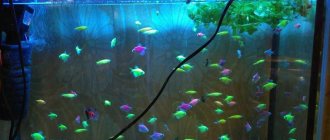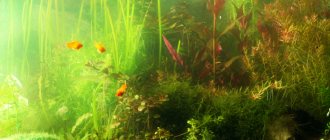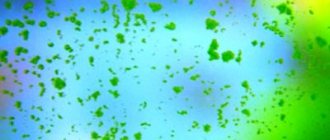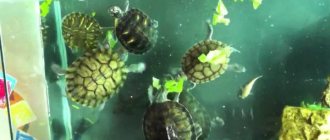An aquarium with fish and green flowers, no matter where it is located, always attracts the attention of others. However, you can enjoy the underwater spectacle if the water in the tank is clean and transparent, but green and cloudy water in the aquarium is not a pleasant sight. Even inexperienced aquarists know that blooming water in an aquarium is an alarming signal for a fish owner. In order not to endanger the inhabitants of the tank, every aquarist should know why the water in the aquarium turns green and how to deal with it.
What is the reason for flowering, what can it lead to?
Any aquarist has at least once encountered water blooms in a fish tank.
Initially, the aquatic environment becomes slightly cloudy, and after a while it becomes green. This process develops spontaneously.
What does this come from? And the reason for this is phototrophic microorganisms (in particular, euglena and chlorella) , which receive nutrition as a result of photosynthesis.
Such organisms are constantly present in the water of the aquarium, but are invisible when the environment is favorable.
But when conditions arise that provoke their activation, they begin to multiply intensively. As a result, a greenish cloud appears. In fact, blooming water does not adversely affect the health of the inhabitants of the aquarium .
However, its aesthetic appearance deteriorates. You should not ignore the problem that has arisen, since green water is a signal of an imbalance. If appropriate measures are not taken in time, it will be more difficult to correct the situation in the future. And this will harm the fish.
They become lethargic and stop taking food. As a result, they are at risk of bacterial diseases. Along with this, vegetation begins to die.
How dangerous is this water?
An excessive amount of decay products in an aquarium not only promotes the rapid proliferation of microorganisms, but also poisons the water with nitrogenous compounds, ammonia, nitrites and nitrates, which ultimately leads to the death of its inhabitants. When colonizing an aquarium, protozoan algae can get into the gills of underwater inhabitants, block air access and cause suffocation. In cloudy water, fish are not able to develop, feed and reproduce normally, and an imbalance of the natural habitat occurs.
Tablets and other means of getting rid of the problem
Nowadays, pet stores sell various products to combat the bloom of aquarium water . It is only recommended to use them in particularly difficult cases, following the attached instructions.
The most effective include:
TetraAqua AlgoStop depot is a drug in the form of dissolvable tablets. It protects the fresh aquatic environment from the development of all kinds of algae. Safe for fish and plants. Price from - 440 rub.- Tetra Algizit is a tablet product for controlling algae in aquariums. Does not have a destructive effect on other vegetation and living world. Ten tablets are enough to disinfect 200 liters. Manufacturer – Germany. Price - from 300 rub.
- Dajana Algicid is an effective Czech remedy for water blooms, produced in 100 ml bottles. One package is designed to process a volume of 500 liters. The optimal dosage is 5:25.
- JBL Algol is a product from a German manufacturer to suppress the growth of algae. Sold in liquid form - the package contains 100 ml. It contains no copper and is therefore harmless to living aquarium inhabitants. The effect of the drug appears immediately after application, and after a few days. One bottle is enough for 400 liters of water.
- Aquarium Pharmaceuticals Algaefix is an effective product indicated for removing algae deposits from the interior surfaces of aquariums. Also used for water purification. Does not harm fish or vegetation. Consumption – 1 ml per 40 liters of aquarium water. One bottle is enough to treat 1400 liter volume. Price from - 350 rub.
- Aquastop is a domestic product that can destroy blue-green and other algae. Does not harm fish or plants. Its action is based on the ability to reduce the pH of water, thereby creating an unfavorable environment for the proliferation of phytoplankton. 100 ml is enough to treat a 200th aquarium with water. Price from - 40 rub.
When flowering is just beginning, it is recommended to resort to the following means:
- streptomycin - taken at the rate of 3 mg per liter of water;
- hyacinth - added to the aquarium in a ratio of 1:10;
- erythromycin is an antibiotic, which is added at the rate of 250 mg per 100 liters.
It is enough to use the listed drugs only once to completely clean the aquatic environment. If you strictly adhere to dosages, the fish will not be harmed.
Useful tips
Sintepon
When combating greening of aquarium water, study a number of special recommendations shared by experienced aquarists:
- Apply a complete darkening of the aqua . Close all the side walls of the container tightly with thick paper and leave it like that for 3-6 days.
- Replace the regular filter sponge with padding polyester . This material effectively kills euglena algae. Do not forget to wash the filter padding regularly (every 3-4 days). But do not remove the sponge that you removed from the filter. Let it float freely in the water and preserve the amount of microorganisms beneficial to the fish.
If you decide to completely darken the aquarium, keep in mind that in the dark, aquatic inhabitants will begin to more actively absorb oxygen, releasing large amounts of CO2. Therefore, in this case, additionally install a good compressor.
An aquarium is a whole world that needs to be looked after and taken care of. The problem of blooming and greening of water is an indicator indicating an unhealthy environmental situation. You can cope with such a nuisance with the help of the information given in this article and our simple recommendations.
Provoking factors
Factors that provoke the violent growth of green algae:
Contaminated soil .
Dirt that accumulates at the bottom over time creates a pathogenic environment for putrefactive formations and the acidity in the water increases. Local inhabitants can no longer cope with cleaning on their own, and the water becomes cloudy.- Foreign substances in water . This means various inclusions: food residues, fish excrement, decaying leaves of plants and shrimp shells. Excess waste creates conditions for the development of microscopic algae, and the level of toxic substances (ammonia and nitrates) in the water increases. This is what phytoplankton feed on.
- Unsuitable place to install an aquarium .
The degree of illumination of the aquarium depends on this. The more intense it is, the more actively euglena algae reproduce. When the duration of daylight exceeds 12 hours, we can soon expect water blooms. Therefore, it is impossible to place a tank with fish near a window, and it is also unacceptable to install high-power lamps. It should be located no closer than 2 meters to the light source, and the recommended spectrum of artificial lighting is 22 Lm per liter of water volume. - Rarely performed filtration . With infrequent water filtration, polluting particles accumulate in large quantities over time. They serve as a breeding ground for single-celled microorganisms. Cleaning must be done at least once every 2 weeks. And also change the sponges in the device at least once a year.
- Incorrect use of chemicals. funds _ Abuse of chemicals, as well as their use not according to instructions, leads to a quantitative imbalance of microorganisms.
- Increased water temperature .
If the water temperature in the aquarium is more than 27 ° C, this leads to cloudiness. It is important to measure the temperature daily and maintain it within 25-27 °C. To solve the problem, you need to move the tank away from the heat source or remove inappropriate artificial lighting lamps (halogen, incandescent lamps) with fluorescent or LED ones. You can use a fan for cooling. - Changing water too often . This leads to the active development of blue-green algae. To avoid this, it is enough to change the water 2 times a month. Just do not do a complete replacement, but a partial one - 30% of the total volume. It is preferable to keep the water at room temperature for about a day before doing this.
- Lack of oxygen .
When the aquarium is overfilled with vegetation, especially in winter with reduced daylight hours, insufficient oxygen production occurs. This is because plants only release it in good light. In return, they synthesize carbon dioxide, which feeds green algae and stimulates their growth. To eliminate the problem, weed and plant mainly plants with slow growth.
Euglena viridis or green euglena
This is the simplest single-celled organism with which all lovers of the underwater world are familiar. Euglena viridis creates a film on the water surface. If the light source does not provide enough light, the algae begins to turn pale. Euglena green begins to actively reproduce under the following conditions:
- A large amount of light;
- The presence of a large amount of organic waste in the water (remains of fish food, waste, etc.). In other words, the equipment is not designed for such amounts of waste and debris. For high-quality cleaning, you need to completely empty the container, clean all the gravel, wash the walls and decor by hand, change the water on time and look for the root cause of the contamination.
- The filtration system is not working properly.
Green Euglena appears and begins to reproduce in the water almost immediately. Yesterday everything was fine, but today the water is already cloudy and covered with a film.
What to do: ways to correct the situation
How to get rid of blooming water correctly? There are 3 key ways to counteract blooming water:
- removal of rotting organic matter and fish waste;
- adjustment of artificial lighting;
- placing the tank at an acceptable distance from the window.
Treatment of the aquatic environment occurs in the following sequence:
- The soil is cleaned of pathogenic inclusions using siphonization.
- Cover the aquarium with opaque paper, turn off the backlight and leave it in this state for a week.
- The filter device is not turned off. Moreover, they increase its power. At this time, this is the only source of oxygen for fish. You can add peat chips to acidify the water.
- The fish are fed once a day in small portions.
There is a high probability that after a week-long quarantine, the water will become light.
Upon completion of therapeutic measures, replace the water volume by 1/5 of the original volume, clean the walls and thoroughly rinse the filter sponges. It is recommended to populate the aquarium with nurse fish - catfish, pacelia, planktonic crustaceans, mollies. They actively eat algal mucus from plants and other surfaces.
It is productive to equip the filter device with an ultraviolet sterilizer. Under its influence, pathogenic microorganisms die.
Natural control of eco-balance
To reduce the number of cyanobacteria to prevent the pond from blooming, you can plant water purifying plants, such as hornwort or hyacinth. Or muffle the sun's rays with large-leaved plants and plants floating on the surface - nymphs, water lilies, egg capsules, which also clean the water well. In the second case, the process of photosynthesis slows down, and microalgae stop multiplying intensively.
The inconvenience of this method is that the mentioned plants cannot overwinter in a pond, so you will need to transplant them into containers and care for them in the winter. Or throw it away completely for the winter.
How to prevent re-blooming?
In order to no longer encounter the problem of water blooms in the aquarium, certain preventive measures are followed:
They systematically resort to mechanical cleaning of glass. The main thing is not to scratch them, and therefore it is better to use non-hard sponges.- Once every 2 weeks, change the water by 1/5 of the volume. First, it is defended for a day.
- Monitor the light level. The aquarium is placed at a distance from the window - 1.5-2 meters. In winter, the duration of artificial illumination should not exceed 10 hours, in summer - 12.
- Representatives that feed on microalgae (for example, daphnia) are introduced into the aquarium. Plants that can absorb nitrates (tubular elodea) are also planted.
- They don’t feed the fish - they give them as much food as they can eat at a time. Then the residues will not rot at the bottom and pollute the water.
- Special chemicals are periodically added to the aquatic environment as a preventive measure.
- Do not allow overcrowding of the aquarium. Crowding of fish, as well as a lot of vegetation, negatively affects the general microclimate.
- Decor (taken from natural bodies of water) planned to be placed in the aquarium is pre-disinfected. Otherwise, the risk of infection increases.
Preventive actions
To ensure that the water in the tank no longer becomes cloudy or turns green, you should adhere to the following recommendations:
- place the aquarium in a place inaccessible to sunlight;
- when laying the soil, make a slope (lay a dense layer of stones towards the front wall);
- set the backlight at the rate of 0.5 W per 1 liter;
- cover the container with a lid to prevent dust particles and insects from getting into it;
- periodically turn off the lighting (there should be no more than 12 hours of light per day);
- regularly inspect the functioning of the devices in the aquarium;
- systematically clean the container, removing plaque from the walls, plants and decorative elements, and also change the water.
Illiterate service
An unscrupulous or inept approach to caring for aquarium inhabitants becomes the most common reason why the water in an aquarium turns green.
Usually aquarists, especially beginners, make the following mistakes:
- Irregular cleaning . Poor cleaning of the container not only leads to water blooms, but also provokes fish diseases. Regular cleaning includes cleaning the aquarium walls and decorative elements from plaque, as well as weeding and pruning overgrown aquatic plants, cleaning the filter and soil.
The smaller the aquarium tank, the more often it should be cleaned, for example, a small 15 liter tank is cleaned weekly, and a large 150-200 liter aquarium is serviced once a month.
- Incorrect water replacement . Both frequent and too infrequent water changes lead to rapid growth of green algae. Remember that water changes are carried out every 2 weeks, and up to 30% of the total water volume should be replaced at a time. When adding new water, do not forget to let it sit (1-2 days) to get rid of excess chlorine.
The temperature of the water added to the aquarium and the water drained should be identical. When replacing, it is better to use a siphon, otherwise turbidity will form in the container.
- Unsuitable food . Poor-quality, low-grade fish food leads to active growth of algae. This problem can be easily resolved:
- Buy only high-quality food from reputable manufacturers.
- Feed your aquarium inhabitants taking into account their natural needs.
- The amount of food should be such that the fish eat it in 1-2 minutes.
- Immediately remove excess fertilizer.
Is it possible to stop the blooming of water bodies?
Today, there are already various types of products that inhibit the growth of microscopic algae, kill them and precipitate harmful products of their vital activity. These include:
- organic and inorganic algaecides;
- microbiological preparations that compete with harmful algae for nutrients, but are safe for the ecosystem;
- special powders that precipitate blue-green algae, mechanically removing their biomass from bodies of water.
However, the use of these funds in such large areas as the Dnieper, its tributaries or the Black Sea coast requires government regulation: subsidies for the purification of water bodies, more stringent regulation of the use of water resources, the quality of filtration of waste and sewer waters [10].
Ukrhydroenergo on its official page also emphasizes the need to regulate the composition of detergents (most EU countries have already introduced restrictions on the use of phosphates in their composition) and the need for measures to improve the health of aquatic ecosystems [11].
About algae
According to modern classification, euglena are no longer considered plants, but belong to protists, although both names can still be found. For the most part, these are single-celled microorganisms, the distinctive feature of which is a mixed type of nutrition. In the light they feed like plants through photosynthesis, and in the dark they feed like animals by eating bacteria. To carry out the process of photosynthesis, the euglena cell contains chloroplasts - organelles with the green pigment chlorophyll, as in plant leaves. Therefore, the intensive reproduction of euglena outwardly looks like the appearance of green turbidity in the aquarium.
Euglena cells contain green chloroplasts
It is worth noting that the blooming of water itself does not cause harm, it only makes the aquarium unattractive. However, an outbreak of euglena algae is an indicator that there is an imbalance in the aquarium, and if action is not taken in time, the situation will become more and more difficult to cope with over time. But the good news is that the fight against these algae is not so difficult, especially if the root causes of their appearance are eliminated.
Unfortunately, it will not be possible to defeat water blooms by creating favorable conditions for higher plants. Because euglena and plants are not serious food competitors and are able to coexist together for a long time. However, other methods have proven to be effective. We will talk about them a little later.
